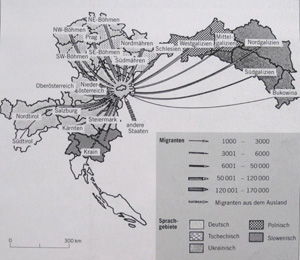4. Immigration to Vienna in the second half of the 19th Century
 Click image to enlarge
Click image to enlarge
Questions
Description and Analysis
By expanding the railway network in the monarchy, the share of foreign migrants increased. These came from the agrarian and crowded regions of Bohemia and Moravia. They were employed as servants to the aristocracy and bourgeoisie and provided a significant contribution to the creation of the “fourth estate” – the industrial working class. In 1856 only 30% of Vienna’s entire population had been born there and a further 18% became indigenous by naturalisation. 47% of the population living in Vienna at that time came from the Austrian crown lands of the monarchy and only 6% came from abroad. Many small traders and craftsmen came from the provincial centres and market towns of the monarchy. The immigration also took place in a centrally organised empire in which the army and government officials – regardless of ethnicity – had the final say.
The settlement with Hungary reduced the immigrants‘ area of origin to the Austrian half of the empire. The settlement, known as the Austro-Hungarian Compromise, was a treaty signed by Austria and Hungary in 1867 on the constitutional relationship between the two parts of the Austro-Hungarian Monarchy. Under this agreement, the former empire of Austria was incorporated into the so-called Dual Monarchy (until 1918). At the end of the 19th century, many Jewish immigrants flowed into Vienna from the area of Galicia, which had been incorporated into the Austrian half of the Monarchy under the Compromise. Around 1900 almost two-thirds of Vienna’s population was foreign.
Answers to the Questions
- Czech
- More than 120,000




Presentation
At the beginning, the main immigrants were German-speakers from Bohemia, Moravia and the Sudetenland. This changed with the construction of railway lines from the middle of the 19th century when the proportion of non German-speaking migrants increased. The economic rise in importance and the construction of the railway lines meant that the seat of power turned into an economic metropolis. Around the turn of the 20th century Vienna became a melting pot of different ethnic and religious groups (e.g Jews). In 1890, 65% of the entire population was made up of what today would be called “people with a migration background”.